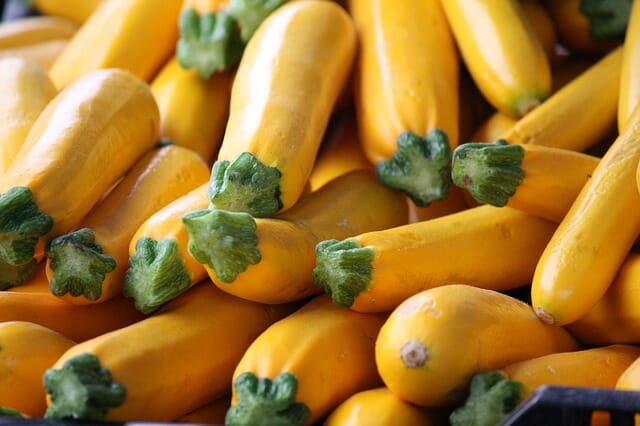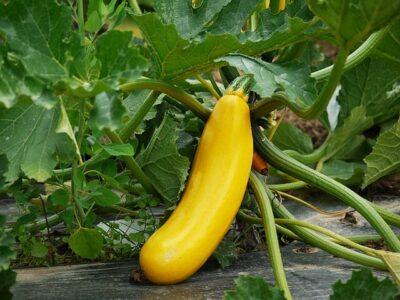For a lot of people, the thought of summer squash brings to mind just a few varieties. The entire list probably consists of little yellow crooknecks and zucchini, with no more than one or two choices of each.
There is a bonanza of summer squash taste available to home gardeners. If you like squash even a tiny bit, you will want to grow your own. Fresh summer squash in your backyard provides daily fresh young produce throughout the season, the ability to eliminate food miles, and the opportunity to try dozens of unique varieties that are not available at stores or even farmer’s markets.
Summer Squash or Winter Squash?
It may be useful to begin by defining “summer squash” as opposed to winter squash. Summer squash, as suggested by the name, are those varieties which can be harvested during the summer. The first fruits of summer squash can be ready for harvest in as few as 40 days after planting and continue to yield for the duration of the season as long as they are picked regularly. Winter squash is not harvested until fall.
Summer squash is best eaten fresh and does not store well. Winter squash should be stored in a root cellar.
Amazing Sea Minerals Helps Grow More Nutritionally Dense Food [2]
The other main difference between summer and winter squash is the skin texture. The skin of summer squash is tender and thin and is usually eaten. Winter squash is generally peeled off and discarded because it is tough and unpalatable.
Summer squash comes in all shapes and sizes, and falls into three major categories: yellow, zucchini, and pattypan.
Some people think of “summer squash” to mean specifically yellow crooknecks, the light banana-colored ones shaped like a lightbulb with an elongated curved end. Most of them are the classic crookneck shape, but some have straighter necks than others and a few are more lemon-shaped with little or no neck at all. They are mild and sweet, best eaten very small — six inches or less in length — as they can quickly become thick-skinned and less appealing. Yellow squash skin can be either smooth or bumpy.
Zucchini Squash: The Type That Make People Run
There is vast variety among zucchini squashes, ranging from the classic green cucumber-sized fruit available year-round in the supermarket to the baseball-bat-sized produce that home gardeners are all too eager to give away during peak season, to the “Holy-cow-what-is-that-thing?!?” varieties.
Zucchinis can end up the brunt of jokes, largely due to their potentially highly prolific habits. People in my region quip that the only time of year they lock their cars is during zucchini season, lest a desperate coworker or passerby seize the opportunity to divest themselves of excess squash. Cookbook author Andrea Chesman advises in her book “Serving Up the Harvest” that “two summer squash plants will provide sufficient squash for…[a] family,” and she warns that “more plants is an embarrassment.” However, zucchinis being my personal favorite, I never heed her advice. I usually plant at least five zucchini cultivars, and only sometimes regret it.
In addition to the Kelly green varieties found in supermarket produce sections and unlocked cars, zucchinis range from light green to almost black, and also can be golden. They are sometimes all one color with smooth skin, but often sport lengthwise contrasting stripes or raised ridges. Their shapes run the gamut, from lightbulb to cucumber-like and are also sometimes round.
More Rare Types of Squash
The “tromboncino” or “rampicante” squash is a unique type of squash. It is usually found in seed catalogs with zucchinis. Unlike other zucchinis which come from the Mediterranean region, the tromboncino originates from Central America and is related to butternut winter squashes. The tromboncino takes well to climbing instead of spreading out like most zucchinis, and needs a stout cage to contain it. The fruits are long and thin, as much as two feet long, while still as slender as a large carrot except for the bulb on the blossom end, and often coil up into a curlicue shape. Immature fruit are eaten and prepared as other summer squash. Tromboncinos can be left on the vine to mature and then eaten as winter squash.
The third category of summer squash is the pattypan type. Also known as “scallopini,” these cute little squashes look like tiny flying saucers, or little pastry tarts, with rounded centers. Harvest Pattypans when they are smaller than teacups. Like other summer squashes, pattypans have distinctive mild nutty flavors and their share of devoted followers. Pick them often during peak season. This will keep them from getting out of control and to encourage regrowth.
Squash Can Be Finicky
A fourth category of squash is the “Lebanese” type, also known as “Mid-East” or “cousa” squashes. They strike me as something between zucchinis and yellow squash — a little milder than zucchinis and a little less watery than zucchini.
Summer squash is easy to grow at home, as long as you have plenty of these two things: sunshine and space.
Squash is finicky about soil temperature. Squash likes very warm soil. Plant them only after the danger of frost has passed. Planting it too early will result in sluggish — if any — germination. Seed packet directions are pretty simple, generally advising to direct-seed 3-5 per hill and thin to 2-3 seedlings per hill. They do best in rich, well-fed soil. Once sprouted, squash will flourish best with a lot of warm sunshine and plenty of water.
Plant summer squash in hills or rows. A few squash varieties work well on trellises. But wherever they are, they will need plenty of space. A tiny seedling, given the right growing conditions, will seem to explode quickly into an enormous plant, often as much as five or six feet across.
Squash Have Pests, Too
As easy as it is to grow, summer squash is not immune to pests. Cucumber beetles, squash bugs, aphids, squash vine borers, and cutworms are insects that can attack summer squash plants. Good ways to control bugs include row cover and organic or conventional pesticides. It is always easier to prevent pest problems than to treat them, but plenty of expert guidance is available to help curtail infestations when they arise. Cooperative extension professionals and volunteers can provide a wealth of information and assistance with identifying and treating plant problems.
Diseases such as blossom end rot, powdery mildew, mosaic virus and verticillium wilt can affect summer squash plants, as well. Combating these conditions can sometimes be a little more challenging than dealing with insects, but perseverance is key. Remedies often can be as simple as adjusting watering habits, but also can include copper fungicide application or soil amendments. Sometimes by the time a problem is visible, it can be too late for that particular plant, but luckily squash grows quickly and it may not be too late for replanting in a different area after destroying the affected plant. For many diseases, it is helpful to look for resistant cultivars. Purchasing seeds said to be powdery mildew-resistant is a smart choice. As with any gardening issue, it is wise to seek advice from local and regional organizations and programs.
Growing summer squash is a joy and will provide households — if not entire neighborhoods and workplaces — with a bounty of fresh delicious produce.
What are your favorite types of squash? What are your best tips for growing squash? Share them in the section below:

